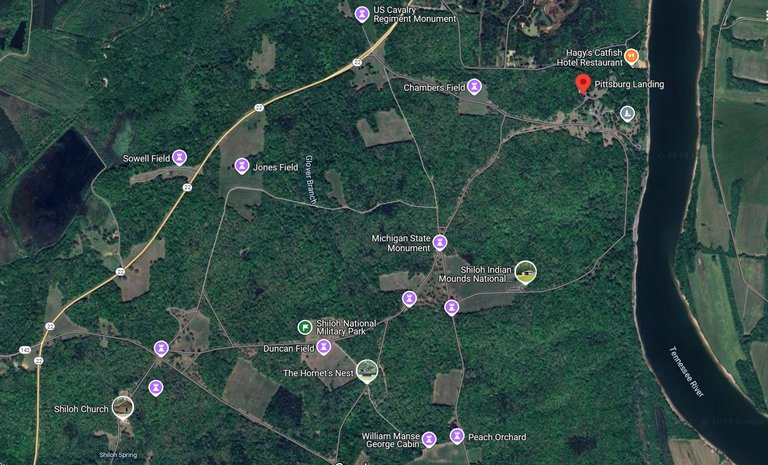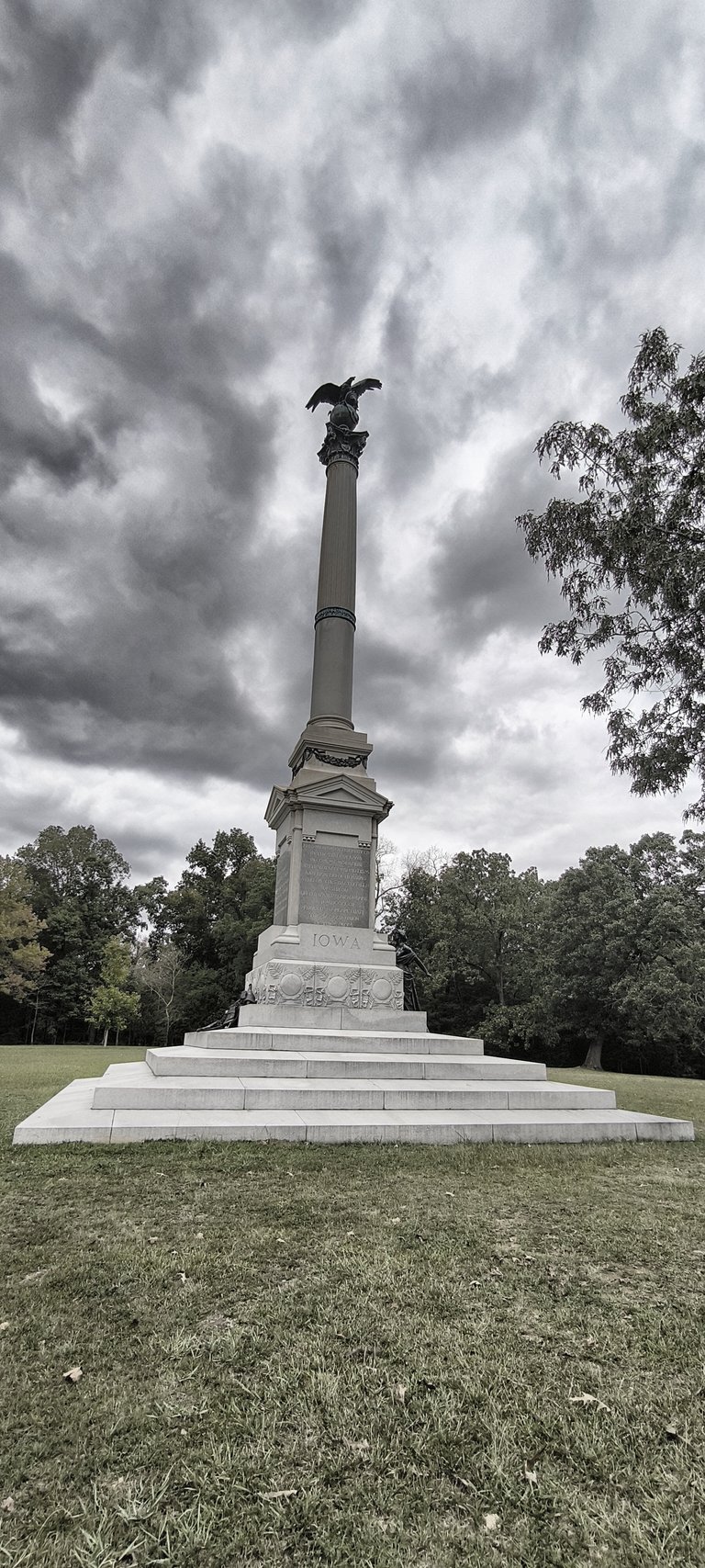It is only a three-hour drive from the big city atmosphere of the music metropolis of Nashville to the quiet nothingness of the area around Pittsburgh Landing. Here, in the no man's land between Savannah and Adamsville, just across the Tennessee River, is one of the historic battlefields of the American Civil War.

Shiloh is a place of which only an old wooden church remains today, but which has nevertheless left a deep mark in the history of the United States.
A surprise attack
The Battle of Shiloh, also known as the Battle of Pittsburgh Landing, was fought between the Union troops under the command of General Ulysses S. Grant and the Confederates under General Albert Sidney Johnston and later General P.G.T. Beauregard.

The Confederates planned a surprise attack on Grant's unprepared troops, who had gathered on the Tennessee River to gain control of the railroad junction of Corinth. On April 6, 1862, the fortunes of battle turned in the Southern troops' favor. On the 7th, the fortunes returned to the Northern troops.

Today, the battlefield is one of the few national parks to be found in the Southern states. But if you visit Shiloh National Military Park, you'd better bring your time. Just walking through the visitor center provides a wealth of information and exhibitions about the battle.

Driven by enthusiasm
There are also maps and models that show how 100,000 men, driven by enthusiasm for their own cause, struck each other and seriously injured or killed each other. The exhibition also includes artifacts, uniforms and weapons used in the battle, as well as interactive displays that trace the events of the two days.

From the visitor center, it is best to drive along the wide streets, along the edges of which numerous monuments and memorial plaques commemorate the course of the battle. The positions of the federal troops are marked in blue, those of the Confederates in red. The commemoration is for the bravery and sacrifice of soldiers on both sides.

The first battle
Of course, Shiloh was one of the first major battles of the Civil War in the interior, and it marked a turning point in the western theater of war. Union troops under the command of General Ulysses S. Grant were initially surprised by Confederate troops under General Albert Sidney Johnston and General P.G.T. Beauregard.

On the first day of the battle, the Confederates managed to push back the Union troops, but the death of General Johnston and the arrival of reinforcements under General Don Carlos Buell on the second day turned the tide of the battle. Union troops were able to recover and repel the Confederate attack, resulting in a Pyrrhic victory for the Union.

Shiloh was one of the bloodiest battles of the war, with a total of nearly 24,000 dead and wounded on both sides. The battle ended in a strategic victory for the Union, but it was so bad that the heavy losses prevented even the victor from profiting from his victory.

A Man behind the victory
General Ulysses S. Grant, who later became the 18th President of the United States, played a crucial role in this battle. His determined resistance and ability to motivate his troops were crucial to the Union victory.
On the other side was General Albert Sidney Johnston, the highest-ranking Confederate general in the West and a highly respected Confederate officer, who was mortally wounded in the battle. His death was a heavy blow to the Confederate troops, who were unable to recover from the loss of their commander.

What is astonishing today is the silence of the place where hundreds of guns from the Army of the Tennessee and the Army of the Ohio fired at the men of the Army of the Mississippi, who in turn fired back.

The Tragedy of the Bloody Six
Here, The Bloody Sixth met their great tragedy: The 6th Mississippi Regiment received orders to attack General William T. Sherman's Union camp and plunged headlong into a deadly crossfire. The regiment's officers rallied their shell-shocked troops to attack two more times within 45 minutes.

Each time, Sherman's troops repulsed the attack, inflicting heavy casualties. Of the 425 men of the 6th Mississippi Regiment who went into battle, few survived these repeated charges into the deadly Union crossfire unharmed.

The 6th Mississippi Regiment lost about 300 men in less than an hour of bloody fighting at Rea Field. In its wake, four hours into the battle, the Confederate offensive nearly collapsed. Communications broke down as exhausted troops became separated from their units.

Killed in crossfire
The dense forest and uneven terrain added to the confusion. But the Mississippians were only the first of many Confederate regiments to suffer here in a deadly scene that was repeated throughout the morning as four Southern brigades braved the same crossfire.

The forest stands silent. Almost no visitors are about. Back then, the rain poured down here incessantly, turning the streets into mire. Today, the sun shines, the bloodstains have disappeared, and the cries of the wounded have died down.

Shiloh is a place of remembrance and reflection, recalling the horrors of war and the sacrifices that were made. A visit here is worthwhile not only for history buffs, but for anyone who wants to understand the significance of this historic event. Emotionally impressive is the stop at Shiloh Church, for which the battle was named. It is a small, unassuming wooden church, next to which stands a new stone church.

A Place of calm
The wooden structure is open, you can go inside and feel the strange atmosphere that this patch of peace represents in the middle of a former battlefield. Just across the street is Shiloh National Cemetery, where many of the fallen soldiers are laid to rest.

The gravestones, arranged in neat rows, tell the stories of those who lost their lives in that bloody battle. The area, once witness to violence and noise, is now a place of reflection and calm, where you can understand the horrors of war.

It takes many hours to drive along the winding roads and recall how people suffered and fought, died and prayed here. The forests and fields where cannons once roared and musket fire pierced the sky are pure nature again. Deer run along the quiet streets and rabbits hop across the meadows.
The cost of Freedom

The quiet here is calming in some ways, but Shiloh remains a place that reminds us of the cost of freedom (hear Gilmour, Crosby, Nash) and the price many had to pay for the unity of the country. A visit here is not only a journey through history, but also a lesson in humanity and the pursuit of peace.

There are other historical sites worth visiting near the battlefield. The Corinth Civil War Interpretive Center in Mississippi offers an in-depth look at the strategic importance of the town of Corinth during the Civil War. The town was a major railroad hub and the site of further battles after the Battle of Shiloh.

More to explore:
Another interesting destination is the Tennessee River Museum in Savannah, Tennessee. The museum features exhibits on the history of the Tennessee River and its importance during the Civil War. Here you can learn more about the river's role as a supply route and its strategic importance to both sides.
Pickwick Landing State Park: A little further afield, this park offers recreational opportunities such as hiking, fishing and camping, and is a nice contrast to the history of Shiloh.
Brices Cross Roads National Battlefield Site: Another battlefield where the Confederates under General Nathan Bedford Forrest won a significant victory, it shows another facet of the war.
















Congratulations @koenau! You received the biggest smile and some love from TravelFeed! Keep up the amazing blog. 😍 Your post was also chosen as top pick of the day and is now featured on the TravelFeed front page.
Thanks for using TravelFeed!
@for91days (TravelFeed team)
PS: TravelFeed is in social media to reach more people, follow us on Facebook, Instagram, TikTok, and X.
Thank you very much and have a great Christmas!
You can check out this post and your own profile on the map. Be part of the Worldmappin Community and join our Discord Channel to get in touch with other travelers, ask questions or just be updated on our latest features.
Congratulations, your post has been added to the TravelFeed Map! 🎉🥳🌴
Did you know you have your own profile map?
And every post has their own map too!
Want to have your post on the map too?
- Go to TravelFeed Map
- Click the create pin button
- Drag the marker to where your post should be. Zoom in if needed or use the search bar (top right).
- Copy and paste the generated code in your post (any Hive frontend)
- Or login with Hive Keychain or Hivesigner and click "create post" to post to Hive directly from TravelFeed
- Congrats, your post is now on the map!
PS: You can import your previous Pinmapple posts to the TravelFeed map.Opt Out
Me dediqué a ver la historia detrás de tu contenido, es bien interesante y a la vez muy triste @koenau. Sabes aquí en cuba hay una estatua con escritos y nombres de caídos muy parecida a la que presentas de IOWA deja buscar la foto.
Muy lindas imágenes todo muy detallado y explicativo me gusto mucho bro. Buen post.
Saludos y feliz navidad 🎄😊🎆 amigo. 🫡
Ligo haré un post de la historia de la estatua de mi país 🇨🇺!!